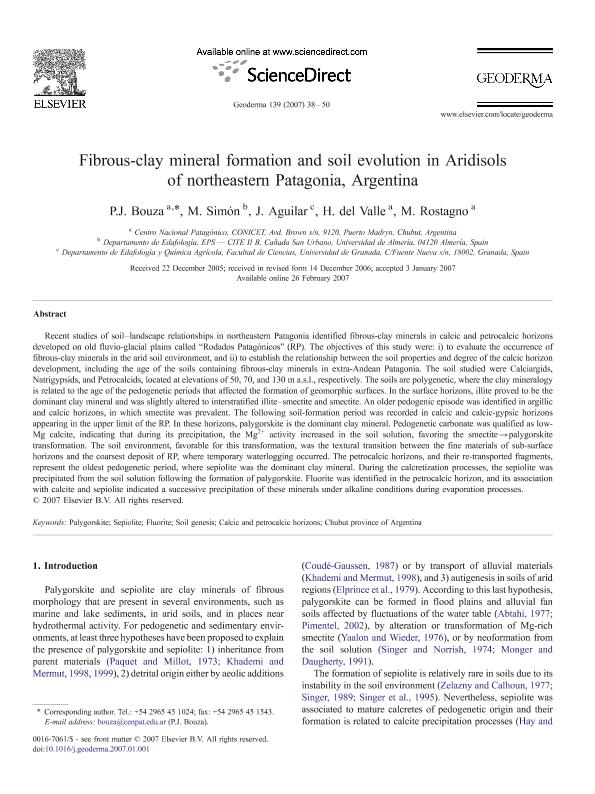Artículo
Fibrous-clay mineral formation and soil evolution in Aridisols of northeastern Patagonia, Argentina
Fecha de publicación:
04/2007
Editorial:
Elsevier Science
Revista:
Geoderma
ISSN:
0016-7061
Idioma:
Inglés
Tipo de recurso:
Artículo publicado
Clasificación temática:
Resumen
Recent studies of soil–landscape relationships in northeastern Patagonia identified fibrous-clay minerals in calcic and petrocalcic horizons developed on old fluvio-glacial plains called “Rodados Patagónicos” (RP). The objectives of this study were: i) to evaluate the occurrence of fibrous-clay minerals in the arid soil environment, and ii) to establish the relationship between the soil properties and degree of the calcic horizon development, including the age of the soils containing fibrous-clay minerals in extra-Andean Patagonia. The soil studied were Calciargids, Natrigypsids, and Petrocalcids, located at elevations of 50, 70, and 130 m a.s.l., respectively. The soils are polygenetic, where the clay mineralogy is related to the age of the pedogenetic periods that affected the formation of geomorphic surfaces. In the surface horizons, illite proved to be the dominant clay mineral and was slightly altered to interstratified illite–smectite and smectite. An older pedogenic episode was identified in argillic and calcic horizons, in which smectite was prevalent. The following soil-formation period was recorded in calcic and calcic-gypsic horizons appearing in the upper limit of the RP. In these horizons, palygorskite is the dominant clay mineral. Pedogenetic carbonate was qualified as low-Mg calcite, indicating that during its precipitation, the Mg2+ activity increased in the soil solution, favoring the smectite → palygorskite transformation. The soil environment, favorable for this transformation, was the textural transition between the fine materials of sub-surface horizons and the coarsest deposit of RP, where temporary waterlogging occurred. The petrocalcic horizons, and their re-transported fragments, represent the oldest pedogenetic period, where sepiolite was the dominant clay mineral. During the calcretization processes, the sepiolite was precipitated from the soil solution following the formation of palygorskite. Fluorite was identified in the petrocalcic horizon, and its association with calcite and sepiolite indicated a successive precipitation of these minerals under alkaline conditions during evaporation processes.
Archivos asociados
Licencia
Identificadores
Colecciones
Articulos(CCT-CENPAT)
Articulos de CTRO.CIENTIFICO TECNOL.CONICET - CENPAT
Articulos de CTRO.CIENTIFICO TECNOL.CONICET - CENPAT
Citación
Bouza, Pablo Jose; Simón, M.; Aguilar, J.; del Valle, Hector Francisco; Rostagno, Cesar Mario; Fibrous-clay mineral formation and soil evolution in Aridisols of northeastern Patagonia, Argentina; Elsevier Science; Geoderma; 139; 1-2; 4-2007; 38-50
Compartir
Altmétricas




